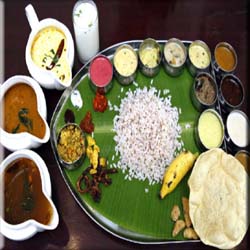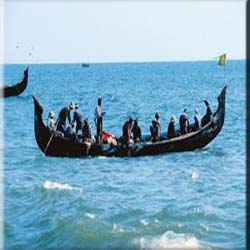CULTURE IS THE ART OF LIVING
Kerala situated in the South of India has its origin dating back to the early 10th century. There are legends associated with the origin of the state which proclaims that Parasurama, an Avatar of Mahavishnu during a war threw his axe into the sea and as a result of which the state of Kerala was retrieved from the water. But geological origin states two reasons for its origin, where the former proclaims that the vibrations of the earth and its crust would have resulted in the coming up of the state.
The culture of Kerala can be best expressed as comprising the following : ORIGIN
One of the reasons for the coming up of the state may be even due to the siliting of the rivers in South India. History says that the early inhabitants of Kerala during the Neolithic times were mainly the Negritos who had a good knowledge of ayurvedic medicines and were also efficient in explaining the natural phenomenon. Followed by the Negritos came the Proto-Australoids who takes the pride of introducing cultivation of rice and vegetables. Then by 700 BC came the Dravidians who are the ancestors of the recent Malayalees from the Mediterranean region. It was during this time that Kerala was influenced by the Mayrayan and then the Cheran Kingdom and feudal Namboothri Brahminical became major powers in the region. By this period the development of Mayalam took place and Kerala became a linguistically distinct region in the early 14th century. Kerala which was taken over by the Cheras soon allied with the Pallavas and defeated the Chola and Pandya kingdoms. It was after the advent of the Aryans that caste system got a strong base in Kerala and today Kerala has various groups of religions and ethinicity where infact many of them take the pride of attributing themselves to the Aryan descent. ETHNICITY
The ethnic values of the Malayalis talks about the bequest and wide spread beauty of the state and the people are usually referred to as Keralites. The ethnic history of the Malayalis has lot of disagreement among the public. The people are classified polygenetic belonging to different ethnic groups and religions. The earliest group of people were the Negritos who were dark skinned and they were mostly tribes such as Kadar, Kanikkar, Malapandarams, Mutuvans, Ullatans, Uralis, Paniyas, etc.Then came the Proto-Australoids who were again dark skinned people and added features of long head and flat nose. They again belonged to the tribes such as Irulans, Kurichiyas, Karimpalans, Mala Arayans, Mala Vetans, etc. But the above two groups superseded by the Dravidians from the Mediterranean region who also came from the North after the arrival of the Aryans in North Western India. The ethnicity of the Malayalis further got subdivided into Nairs, Vellalas, Kammalas, Ezhavas, Pulayas, Parayas, Kuruvasand the Namboothri Brahmins. Namboothiries represent the later elements among the Brahmin migrants and Nairs are mixed origin of Dravida, Arya, Sithiya races. Today Malayalis belongs to a multi ethnic group though some take the pride of introducing themselves in all religious rituals as 'Mama Arya Putra' meaning the son of the Aryans. CULTURE
Though Kerala occupies a small part of the South of India it is noted for its varied cultural heritage which includes the arts, cuisines and dance forms. To know what a cultural synthesis is, one can study the culture of the people of Kerala which has been contributed by people of different races. The culture of the Malayali's are also said to be the culture of the whole country. The culture of the Malayalis are deep rooted because it was adhered to by the unity, continuity and universality of the Malayalis. Lot of importance is given to religion, philosophy, language, art, education and social organization which has its own distinct malayali characteristics. Both the Aryan and the Dravidian culture are synthesized to get the present culture of the Keralites who have taken all the pain to maintain the antiquity of the region. The Koodiyattom takes the pride of being announced by the UNESCO as the Human Heritage Art. This performing art is a form of drama or theatrical representation of epic stories of Gods. Kathakali and Kali are other two performs of performing art which depicts the ancient epics. Kalarippayattu is another famous art of Keralites gaining worldwide attention though in between it had a small dip. Kalarippayattu is a fight which is performed in the form of an art. TRADITIONS
Kerala fondly known as God's own country has a wonderful tradition in the history of Malayalis with lot of ethnic values and cultures. Apart from Hinduism, Christianity and Muslims there are also Buddhism, Jainism, Sikhism and Judaism religions in a very very small proportion. There are some traditional festivals like Onam and Vishu which is followed with great pomp. Apart from these traditional festivals, other festivals like Diwali, Christmas, Milad-e-Sherif, Holi, Easter, Id-ul-Fitr are celebrated with equal enthusiasm. The theatrical shows of Mohiniattam, Kootiyattam and Kathakali reveal their traditional values and also show what great lovers the Malayalis are with art and literature. The people of Kerala very much adhere to their culture and traditional customs and might even go to a great extent to maintain it. They have lot of traditional medicines which is mainly based on herbs and is believed to work wonders. They mostly follow traditional method of homemade remedies in the form of oils, powders and soaps to take care of their bodies. ARTS AND CRAFTS
Kerala and the keralites are known for Ayurveda and ite related medicines. Today, it is a unique, indispensable branch of medicine, a complete naturalistic system that depends on the diagnosis of your body's humours, vata, pitta and kapha - to achieve the right balance. Kerala is also known as the Land of Ayurveda. The people of Kerala are known for their handicraft items especially the carvings in rosewood and sandalwood. Kerala also gets a unique identity of colouring or painting the body parts with henna and related colours. CUISINE

OCCUPATION

FAMOUS PERSONALITIES
Raja Ravi Varma - From Travancore is a great painter who showed a blend of Indian and European art techniques.Kavalam Narayana Panicker - renowned dramatist and poet.
Irayimman Thampi - Famous Carnatic musician as well as a music composer from Kerala.
Arundhathi Roy - Award winner for the Booker prize.
Shobana - Famous Bharatanatyam dancer.


